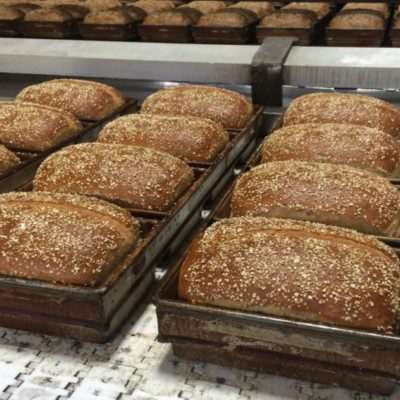Relevant considerations for pan oilers
- Pan oilers need to be adjusted to deliver a preset amount of lubricant inside the pan in the very small window of time they have, depending on pan conveyor speed. Intermittent spraying reduces oil waste and minimizes line cleanup.
- Such equipment should be able to work consistently. It should spray an exact and precise amount of lubricant, with a normal and permitted deviation between oil applications.
- Misting phenomena during oil coating is undesirable as it leads to lubricant waste and poor oil distribution.
- Spray nozzles should be regularly serviced and cleaned according to the maintenance and cleaning programs. Poorly maintained nozzles can get clogged and become a contamination source for products.
- Nozzles can be arranged in hygienically designed manifolds for a variety of conveyor widths and pan designs.
- While not in use, oil should be stored at ambient temperature (not above 86°F or 30°C) and below 60% relative humidity.
- Pan oilers should be included in production startup checklists. Production managers and supervisors should always check that pan oiling machines are running smoothly as consequences of improperly lubricated pans can be considerable.
- Food-grade lubricants, those that fall under NSF classification should not be used for pan lubrication. H1 Lubricants are used for reducing friction, especially in mechanical parts of food machinery (e.g. bearings and shafts). These lubricants are to be used where the possibility of contact with food exists (i.e. incidental food contact).1
Application
In practice, the effects of applying too much or too little lubricant in pans vary. The key thing is that either scenario is undesirable.
Effects of over-lubrication of pans:
- Excess oil accumulates in the bottom of pan
- Spots on product crust become visible
- Excessive use of lubricant
- Over-baked product sidewalls
- Cleaning of pans may take longer
Effects of under-lubrication of pans:
- Product crust sticks to pan’s interior surfaces
- Generation of waste at deppanner as damaged product cannot be reworked
- Under-baked product sidewalls
Pan glazing and silicone coating can be used as alternatives to lubrication. Most pans in high-speed bakeries are coated with a silicon solution that greatly reduces, and in some cases, eliminates pan oiling or in-house lubrication.
Pans are treated either by spraying with, or immersion in, a silicone solution and then cured by holding at elevated temperatures for several hours. The resultant coating facilitates deppaning of loaves. The coating applied usually lasts for more than 400 baking cycles before reglazing of pans is required.
The type of grease or oil used for pan oilers is also important. Its selection is based on their physical properties, chemical composition and baking performance (stability to oven settings).
Some properties and features of pan lubricants include
- Usually made from a blend of soy and vegetable oil
- Highly saturated (high content of saturated fatty acids)
- High smoke point (key for high temperature baking)
- Relatively stable to oxidative rancidity
- Low iodine values
- Liquid and whitish appearance
References
- De La Cruz García, C., Sánchez Moragas, G., and Nordqvist, D. “Food Contact Materials.” Food Safety Management. A Practical Guide for the Food Industry, Academic Press, Elsevier Inc., pp. 403–405.

